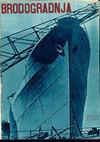应用离线灰盒法预测操纵性能
IF 3.9
4区 工程技术
Q1 ENGINEERING, MARINE
引用次数: 0
摘要
为安全航行和有效设计船舶而进行的操纵性能预测越来越依赖于人工智能(AI),主要是数字孪生技术。这项技术需要一个物理船舶的数字模型。这些模型的流体力学系数和参数通常通过两种实验方法获得:平面运动机制(PMM)和圆周运动试验(CMT)。这些方法耗时且昂贵,在设计过程的早期阶段可能并不可行。本研究通过在船舶上实施灰箱方法,研究了一种替代这些方法的经济有效的方法。在首次实施过程中,使用了一艘全尺寸油轮的 "之 "字形机动人工训练数据。通过比较油轮的模拟和自由运行模型试验结果,进行了验证研究。在第二次实施中,选择了汽车运输船的比例模型,并结合了几种数值搜索方法,以获得更精确的数字模型。通过这种组合确定的三自由度(DOF)机动建模组(MMG)模型经过模拟验证,并与各种机动的自由运行模型试验结果进行了比较。本研究的贡献在于准确捕捉了物理模型的操纵特性,这是通过使用调整区间和灰盒法的各种数值搜索方法组合实现的。因此,所开发的模型可在今后的研究中作为更快的决策工具,用于在船舶设计中确定船舶的直线稳性或不稳定性,以及预测船舶的操纵性能。本文章由计算机程序翻译,如有差异,请以英文原文为准。
Application of an offline grey box method for predicting the manoeuvring performance
The prediction of manoeuvring performance for safe navigation and effective design of ships increasingly depends on artificial intelligence (AI), mainly digital twin technology. This technology requires a digital model of the physical ship. The hydrodynamic coefficients and parameters of these models are commonly obtained through two experimental methods: the planar motion mechanism (PMM) and the circular motion test (CMT). These methods are time-consuming and expensive, which may not be feasible during the early stages of the design process. This study investigates a cost-effective alternative approach to these methods by implementing a grey box method on ships. For the first of these implementations, a full-scale tanker ship was applied with artificial training data of zigzag manoeuvres. A validation study was carried out by comparing the simulation and free-running model test results of the tanker. For the second of these implementations, a scale model of a car carrier was selected, and several numerical search methods were combined to obtain a more accurate digital model. The 3-degree-of-freedom (DOF) Manoeuvring Modelling Group (MMG) models identified through this combination were validated with simulations and compared with the free-running model test results for various manoeuvres. The contribution of this study lies in the accurate capture of the manoeuvring characteristics of the physical model, which is achieved through the use of the adjustment interval and the combination of various numerical search method of the grey box method. Consequently, the developed model can be used in future studies as a faster decision-making tool for determining the straight-line stability or instability of a ship in the ship design and in predicting the manoeuvring performance of the ship.
求助全文
通过发布文献求助,成功后即可免费获取论文全文。
去求助
来源期刊

Brodogradnja
ENGINEERING, MARINE-
CiteScore
4.30
自引率
38.90%
发文量
33
审稿时长
>12 weeks
期刊介绍:
The journal is devoted to multidisciplinary researches in the fields of theoretical and experimental naval architecture and oceanology as well as to challenging problems in shipbuilding as well shipping, offshore and related shipbuilding industries worldwide. The aim of the journal is to integrate technical interests in shipbuilding, ocean engineering, sea and ocean shipping, inland navigation and intermodal transportation as well as environmental issues, overall safety, objects for wind, marine and hydrokinetic renewable energy production and sustainable transportation development at seas, oceans and inland waterways in relations to shipbuilding and naval architecture. The journal focuses on hydrodynamics, structures, reliability, materials, construction, design, optimization, production engineering, building and organization of building, project management, repair and maintenance planning, information systems in shipyards, quality assurance as well as outfitting, powering, autonomous marine vehicles, power plants and equipment onboard. Brodogradnja publishes original scientific papers, review papers, preliminary communications and important professional papers relevant in engineering and technology.
 求助内容:
求助内容: 应助结果提醒方式:
应助结果提醒方式:


